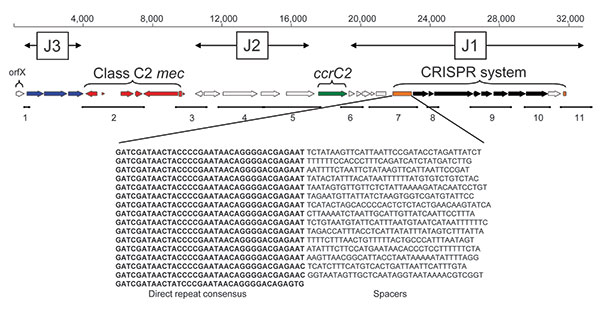Livestock-associated Methicillin-Resistant Staphylococcus aureus Sequence Type 398 in Humans, Canada
George R. Golding, Louis Bryden, Paul N. Levett, Ryan R. McDonald, Alice Wong, John Wylie, Morag R. Graham, Shaun Tyler, Gary Van Domselaar, Andrew E. Simor, Denise Gravel, and Michael R. Mulvey

Author affiliations: National Microbiology Laboratory, Winnipeg, Manitoba, Canada (G.R. Golding, L. Bryden, M.R. Graham, S. Tyler, G. Van Domselaar, M.R. Mulvey); Saskatchewan Disease Control Laboratory, Regina, Saskatchewan, Canada (P.N. Levett, R.R. McDonald); Royal University Hospital, Saskatoon, Saskatchewan, Canada (A. Wong); Cadham Provincial Laboratories, Winnipeg (J. Wylie); Sunnybrook Health Sciences Centre, Toronto, Ontario, Canada (A.E. Simor); Public Health Agency of Canada, Ottawa, Ontario, Canada (D. Gravel)
Main Article
Figure 3

Figure 3. Schematic of the novel staphylococcal cassette chromosome (SCC) mecV subtype and DNA sequence of the clustered regularly interspaced short palindromic repeat (CRISPR) array identified in Staphylococcus aureus isolate 08 BA 02176. Red and green arrows represent mec and ccr complexes, respectively. Blue arrows represent 3 open reading frames (ORFs) in the J3 region sharing sequence identity with chromosomal genes of S. epidermidis RP62A. Orange boxes indicate confirmed and questionable CRISPRs. Black arrows represent CRISPR-associated genes. Location of primer sets used for coverage of this SCCmec element are numbered 1–11 (Table 4) and illustrated as solid lines. Shown below the schematic is the DNA sequence of the confirmed 1,107-bp CRISPR array in the J1 region, which provides the 36-bp direct repeat consensus (boldface) and the variable 15 spacer sequences.
Main Article
Page created: December 28, 2010
Page updated: December 28, 2010
Page reviewed: December 28, 2010
The conclusions, findings, and opinions expressed by authors contributing to this journal do not necessarily reflect the official position of the U.S. Department of Health and Human Services, the Public Health Service, the Centers for Disease Control and Prevention, or the authors' affiliated institutions. Use of trade names is for identification only and does not imply endorsement by any of the groups named above.
